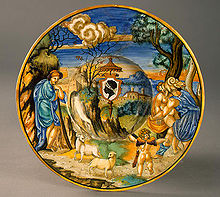Francesco Xanto Avelli
- Francesco Xanto Avelli
-

Francesco Xanto Avelli,
Neptune enlevant Théophane (armes des Pucci sous l'ombrelle) (1532)
Francesco Xanto Avelli (Rovigo, ~1487 - ~1542) est un peintre et un céramiste italien maniériste connu pour ses majoliques.
Biographie
Né à Rovigo, il part en 1530 à Urbino (le texte de ses dédicaces comprend in Urbino à partir de cette date).
Puis par souci d'être mieux reconnu et que ses exigences soient acceptées, il appose également sa signature et la date de réalisation sur toutes ses œuvres.
Il s'inspire de thèmes allégoriques, mythologiques car il est instruit et s'adonne aux écrits poétiques en l'honneur du duc d'Urbino, et ne néglige pas les événements contemporains rapportés par la littérature (Sac de Rome)[1].
Œuvres
- Conversion de saint Paul (1525, lieu non précisé), National Gallery of Art, Washington
- Vénus déguisée en chasseresse (1530, Urbino), MET
- Arethusa Fleeing Alpheus (1531, Urbino), Philadelphia Museum of Art
- Orphée descendant aux enfers (1532, Urbino), Wallace collection
- Vie du roi Anius : ses filles échappent de la prison d'Agammemnon quand Bacchus est parti chercher de l'eau (1532, Urbino), Metropolitan Museum of Art, New-York
- Histoire de Phaëton (1532, Urbino), MET
- Histoire d'Apollon (1532, Urbino), MET
- Énée et ses compagnons devant la tombe de Polydore (1532, Urbino), MET
- Enlèvement de Théophane par Neptune (1532, Urbino), National Gallery of Art, Washington
- Triopme de Neptune (1533, Urbino), Wallace collection
- Abduction d'Hélène (1534, Urbino), Getty Center
- Glaucus et Scylla (1535, Urbino), Wallace collection
- La vestale Tuccia apportant de l'eau au temple de Vesta (1538, Urbino), Wallace collection
- Héros se jetant de la tour (1538, Urbino), National Gallery of Art, Washington
- Lacoon et ses fils (1539, Urbino), National Gallery of Art, Washington
- Plats avec les armes de la famille Pucci (1532), Cleveland Museum of Art
- Salière (1534, Urbino), British Museum, Londres
Voir aussi
Liens internes
Liens externes
Notes et références
Wikimedia Foundation.
2010.
Contenu soumis à la licence CC-BY-SA. Source : Article Francesco Xanto Avelli de Wikipédia en français (auteurs)
Regardez d'autres dictionnaires:
Francesco Xanto Avelli — (c. 1487? ndash; c. 1542?) [These dates are put forth in the biography provided by the J. Paul Getty Museum; they appear, however, to be highly conjectural.] was an Italian ceramicist. He is best known for his painted maiolica works.LifeXanto… … Wikipedia
Xanto Avelli, Francesco — (c1487 Rovigo 1542 Urbino) (Italy); aka Avelli, Francesco Xanto / Fra Xanto / Rovigo da Urgino Maiolica ware painter in Urbino. He used imagery from paintings and prints in his work, including Raimondi s explicitly erotic I modi. Source:… … Dictionary of erotic artists: painters, sculptors, printmakers, graphic designers and illustrators
Avelli, Francesco Xanto — see Xanto Avelli, Francesco … Dictionary of erotic artists: painters, sculptors, printmakers, graphic designers and illustrators
Fra Xanto — see Xanto Avelli, Francesco … Dictionary of erotic artists: painters, sculptors, printmakers, graphic designers and illustrators
Liste de peintres italiens — Le foisonnement très important des peintres italiens s explique par le nombre des mouvements et des courants qui se sont développés surtout depuis la Renaissance italienne. Écoles de peinture en Italie Certains des peintres œuvrant en Italie… … Wikipédia en Français
Maiolica — Istoriato decoration on a plate from Castel Durante, c.1550 1570 (Musée des Beaux Arts de Lille) Maiolica[1] is Italian tin glazed pottery dating from the Renaissance. It is decorated in bright colours on a white background, frequently depicting… … Wikipedia
Urbino maiolica — ▪ pottery maiolica also spelled Majolica, Italian (Italy) tin glazed earthenware made in the city of Urbino, which from around 1520 dominated the market. Early wares, mostly dishes, are decorated with narrative scenes that typically cover the … Universalium
Cultural depictions of Cleopatra VII — Cleopatra VII and her reign have been the subject of literature, films, plays, television programs, and art. PLEASE NOTE: Only those with Wikipedia articles are cited Contents 1 Advertising 2 Art 3 Astronomy 4 Ballet … Wikipedia
1480s in art — The decade of the 1480s in art involved some significant events.Events* 1482: A Milanese Duke commissioned Leonardo da Vinci to make an equine statue that would have been the largest in the world. A clay cast was made over 16 years but the… … Wikipedia
Manierisme — Maniérisme Présentation générale Histoire de la peinture Mouvements picturaux A … Wikipédia en Français

